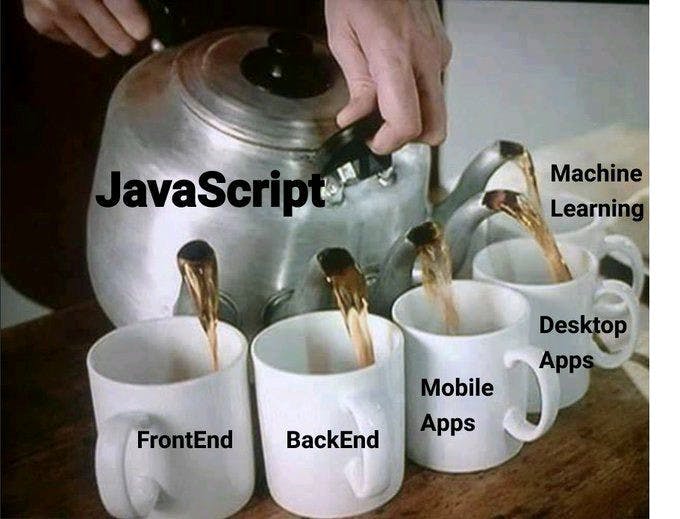WHY JAVASCRIPT AT ALL?
The vast majority of content-based websites, like news websites and various blogs, essentially render read-only and static bulk. With increasing demand and the need for interactivity on various websites, JavaScript has become a core web technology and is used with HTML and CSS (for text markup and style, respectively).

According to MDN, JavaScript is a programming language that adds interactivity to your website. Since it was invented by Brendan Eic, immense mechanisms have gone into broadening its scope, providing far-reaching functionality that is utilized with ease.
Such interactivity and functionality have also proven useful in many non-browser environments, such as Node.js, Apache CouchDB, and Adobe Acrobat.

JavaScript is used to create dynamically updated content, in multimedia control, to run code in response to specified events occurring on the webpage, to animate images, to implement interactive behaviors on web pages, and is also commonly used to dynamically modify HTML and CSS to update a user interface.
WHAT DOES IT MEAN FOR JAVASCRIPT TO BE DYNAMIC?
Computer languages are either static or dynamic, meaning to be 'fixed' or 'capable of action or change', respectively. With time, dynamic computer languages have become so important with the rising need for freedom when it comes to the type of data to be stored in a variable, making website maintenance easier and faster and, additionally, performing type checking at run time as opposed to checking at compile time.
JavaScript is commonly known to be dynamic and loosely typed because it is pliable.
A brief illustration would be using a variable, which is basically a container for data (or value). A variable is declared using the keywords "let," "var," and "const," which can then be assigned multiple values of various data types (without the need to specify its data type). On the other hand, variables in static languages (such as C++, C, C#, Scala, Kotlin, Fortran, etc.) would have to be declared and followed by a mandatory specification of the data type to be stored.
JavaScript is dynamic in the sense that it allows the display of a web page or app to be updated to show different items in different situations while producing new content as needed.
JAVASCRIPT: WHAT TO EXPECT DIVING IN.
There are so many aspects to take into consideration when dealing with the needs that end users of websites and web applications see and interact with. Browsers are such a significant part of any user's online experience, and elevating this comes hand-in-hand with how interactive such browsers were developed to be.
A good place to kick off a new journey would be its basics, here are a few;
- Variables
In the previous section, I briefly talked about a variable, which is the most basic building block in JavaScript as it helps us to effectively store anything just once and be made available for re-use again (which is fantastic for handling large amounts of data).
- Operators
These are simply special symbols used to perform various actions on the operands. Operators are important when it comes to assigning values, performing comparisons, performing arithmetic operations, and so much more. This demands their optimal understanding and their appropriate use.
- Functions
This word is quite ambiguous; here, it refers to a body of code designed to perform a particular task while making it available for reuse. It is a set of JavaScript statements that perform a task that is considered valid only when it can accept input and return a resonating output.
It is usually executed when an event invokes it.
- Events
These are the things that happen in the browser environment, such as a user clicking an HTML element, pushing a keyboard key, or scrolling either up or down the browser's window. It could seemingly be as insignificant as hovering over an HTML element or clicking the primary mouse button.
Events are code structures that pay attention to these occurrences and respond by running whatever code you specified beforehand.
Handling these events is so important for improving the overall user experience and is the key to real interactivity in a browser's environment.
- Conditionals
Conditionals in JavaScript provide a means to control code behavior by deciding whether or not a block of code can run. There are different types of conditionals to cater to the different needs of different situations.
These so far make up the core of JavaScript and give a surface-level insight into what to expect when diving into JavaScript as a whole.
More intricate aspects include classes and inheritance, the Document Object Model (DOM), the heart of JavaScript, arrays, object-oriented programming, asynchronous JavaScript, and JavaScript modules. All of which would not be covered in this article.
REAL-LIFE APPLICATIONS OF JAVASCRIPT.
'"Front-end development is at the intersection of art and logic; business and expression; left brain and right brain; design and nerdery. I love it."
-Chris Coyier.
JavaScript is a client-side language, which technically makes it a front-end language. As a job title, "front-end developer" is fairly well-defined and understood, provided the job is centered around the browser and building websites.
Admittedly, this job has evolved over the decades, and there seems to be a pile of new roles pinned to its name: front-end developers have come to be responsible for taking charge of new prospects and have found themselves asking questions that once would've been answered by back-end developers or design experts.
JavaScript makes all of it much easier, and with a basic understanding of how it works, applying it to real-life scenarios becomes possible. You can create anything from interactive advertising to custom-made games and apps.
JavaScript makes it possible for developers to implement features like:
Adding hover effects.
Playing audio and video on.
Adding animations.
Creating a responsive navigation bar.
Creating drop-down menus.
Responsiveness on social-media-like interfaces.
Enforcing required fields in forms to ensure submission of complete forms.
Responsive content in terms of change in window size.
Dashboards for tracking real-time data.
Updates certain pieces of content on the page without updating the entire page.
To Sum It Up.
JavaScript is a powerful programming language with extensive use in web development and is a valuable addition to your skillset as a front-end developer.
Excellent resources to help your JavaScript journey
Learn JavaScript the interactive way with W3School, FreeCodeCamp, LearnJS, JavaScript: First Steps, SoloLearn, and others.
Learn JavaScript the visual way with; FreeCodeCamp, Scrimba, and Developedbyed.
Learn JavaScript with twitter;
Tweets with amazing learning materials: Shashwat Nautiyal, Swastika Yadav, Abhee Krishna.
JavaScript cheat sheets for various concepts: Basics, Operators, Data types, Selectors, String Methods, Array Methods, and The ultimate JS cheat sheet.
